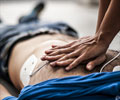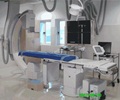Survival rates following cardiac arrest went up 300 percent when emergency responders used Cardiocerebral Resuscitation, a new resuscitation approach for cardiac arrest
300% increase in the survival rates by a new resuscitation approach for cardiac arrest pioneered at The University of Arizona Sarver Heart Center. When emergency responders used Cardiocerebral Resuscitation, the new technique that does away with mouth-to-mouth breathing, it enhanced the willingness to perform resuscitation in lay individuals.
'In out-of-hospital cardiac arrest, the brain and the heart need resuscitation, not the lungs,' said Gordon A. Ewy, director of UA Sarver Heart Center, where the new approach was developed. Ewy is one of few people in the world named a 'CPR Giant' by the American Heart Association.In CPR according to current AHA guidelines, 30 chest compressions are delivered, followed by two mouth-to-mouth breaths. While the responder presses on the chest, oxygenated blood is moved through the body and delivered to the organs.
'But when you stop chest compressions to give mouth-to-mouth ventilations, no blood is moved and the organs essentially are starved,' Ewy says. 'In fact, during CPR, blood flow to the brain and the organs is so poor that stopping chest compression for any reason – including so called 'rescue breathing' – is not helpful.'
At the American Heart Association's 2006 Scientific Sessions in Chicago, Ewy presented data from Emergency Medical Services in the Phoenix Metropolitan Area showing that 9 percent of out-of-hospital cardiac arrest victims survived after the implementation of Cardiocerebral Resuscitation. This equals a 300-percent increase compared to the time when first responders used guideline CPR, resulting in a mere 3 percent survival rate.
As a cause of death, out-of-hospital cardiac arrest is second only to all cancer deaths combined, taking the lives of 490,000 Americans every year. Despite periodic updates in the CPR guidelines, survival rates following out-of-hospital cardiac arrest have remained dismal over the past 20 years, hovering between 1 and 3 percent in most large cities in the United States. Survival rates are better only if an automated external defibrillator (AED) is available and is used soon after the cardiac arrest.
'We think CPR is not optimal because it is advocated as a 'one-size-fits-all' approach, ignoring that cardiac arrest and respiratory arrest are two distinct pathophysiological conditions,' says Ewy. 'Ventilations are necessary in cases of respiratory arrest, such as near-drowning accidents or drug overdose.'
Advertisement
'As a result, people interrupt the chest compressions for prolonged periods of time,' says Ewy. 'This does not provide optimal perfusion of the vital organs.'
Advertisement
Because it does not involve mouth-to-mouth breathing, Cardiocerebral Resuscitation enhances the willingness in lay individuals to engage in an attempt to resuscitate a cardiac arrest victim. Members of the UA Sarver Heart Center CPR Research Group started the 'Be a Lifesaver' program to teach the new approach to the public at no charge. Bystander Cardiocerebral Resuscitation is easy to learn and easy to remember. To learn more about the program and to watch an instructional video online, visit www.heart.arizona.edu.
Bystander Cardiocerebral Resuscitation involves three simple steps:
1. Direct someone to call 911 or make the call yourself.
2. Position the patient on the floor. Place the heel of one hand on the center of the chest with the other hand on top of the first. Lock your elbows and perform forceful chest compressions at a rate of 100 per minute. Lift your hands slightly after each push to allow chest to recoil. Take turns with a bystander until paramedics arrive.
3. If an automated external defibrillator (AED) is available, attach it to the patient and follow the machine's voice instructions. Otherwise, keep pumping.
NOTE: Gasping is not an indication of normal breathing or recovery. Initiate and continue compressions even if patient gasps. For cases of suspected drowning, drug overdose or collapse in children, follow guideline CPR (2 mouth-to-mouth breaths for every 30 chest compressions).
Source-Eurekalert
SRI










